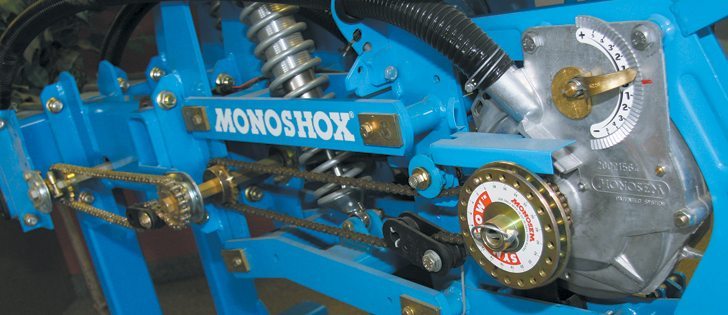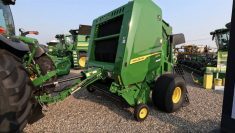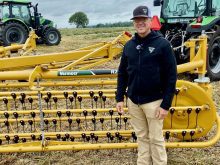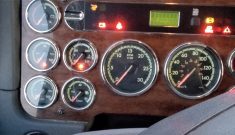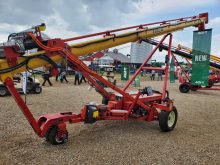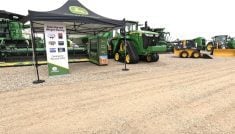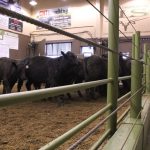PORTAGE la PRAIRIE, Man. — In the quest for perfect canola seed placement, some producers try corn planters designed for large seeds, while others use vegetable planters designed for microscopic carrot seeds.
But in southwestern Alberta, farmers latched onto the benefits of the Monosem Precision Vacuum Twin-Row Planter about 20 years ago. About 100 producers in the Lethbridge area use the high-end corn planter.
Berry Clements of Taber has owned a half dozen of the precision planters.
“We’ve used them in this country for years planting sugar beets,” he said.
Read Also
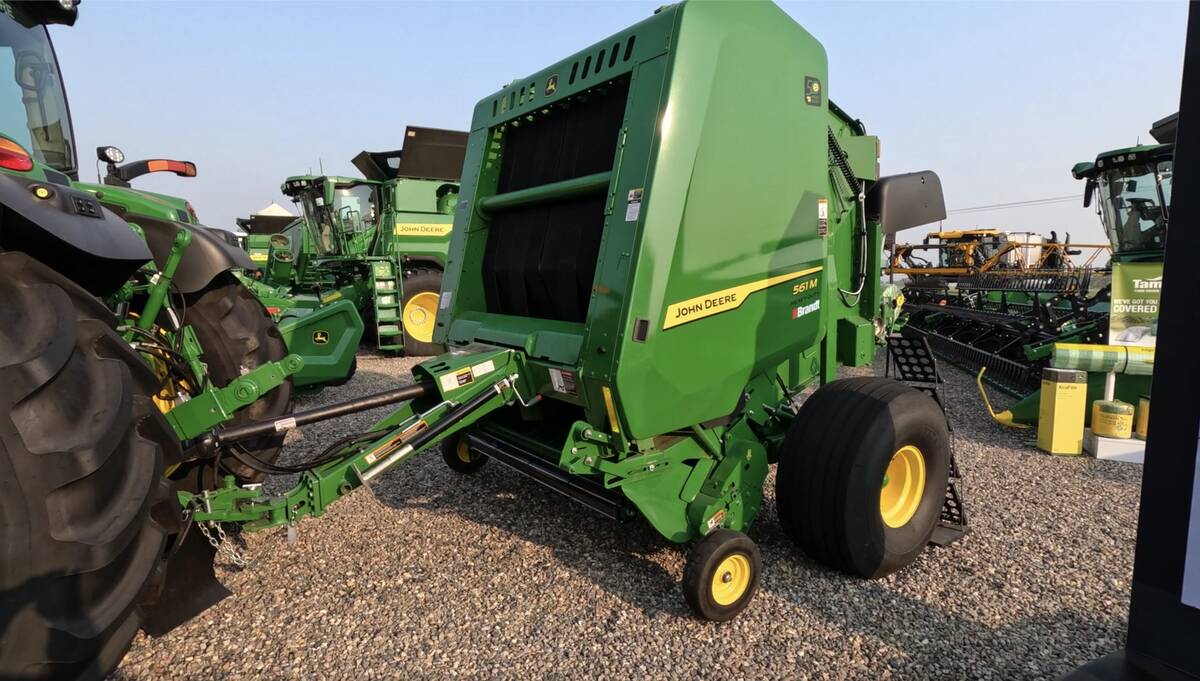
John Deere balers get weave automation
John Deere’s 1 Series round balers for 2026 will include an automated weaving hitch that oscillates the unit over a windrow to better form a “square-shouldered” round bale.
“In recent years, I’ve used three different Monosems for canola seed production. We do five (irrigation pivots), so that’s between 650 and 700 acres a year.”
Clements plants everything on single rows with 22 inch row spacing. Hybrid canola goes in with 1.25 inches between seeds. Corn goes in at either eight or nine inches between seeds.
“We always get perfect spacing, exactly what we want, unless it’s really windy. In high wind conditions, it (wind) actually holds the canola seed suspended in the air slightly, just enough to delay the seed drop a little. But in normal conditions, it’s perfect.
“In the past, I’ve used John Deeres on beets and corn, but now we only buy the Monosems. That gives us better versatility for all kinds of crops and better separation.”
That ability to accurately place any sized seed in twin rows, from seeds as small as carrot seeds, to those as large as corn, soybean and Lima beans is what drives Monosem’s popularity, said Todd Botterill, a Monosem representative in Newton, Man.
Monosem arrived on vegetable farms in California from Europe about 30 years ago.
Its metering system was developed in the Netherlands, the openers were French design and the toolbars were built in California.
Today, the company is based in Edwardsville, Kansas.
Although Monosem started out solely as a vegetable planter, farmers soon put it to work to seed corn and soybeans.
The machine’s range eventually crept north to Alberta and east to Georgia and South Carolina, but few farmers on the northern Great Plains had heard of the Monosem planter.
The large jump in corn acres and corn prices, combined with new, twin row technology, prompted growers to look beyond the usual American planters as they switched to new seeding systems.
At the same time, canola expanded into new areas, from Oklahoma to the U.S. East Coast. Farmers in those regions wanted to use the same planters they used for their other crops to seed winter canola.
The Monosem is suited to the task, said Botterill, adding the Monosem was designed to plant seeds smaller than canola.
“The standard JD, Kinze and Case planters are designed for big seeds like corn and beans. They have recessed cells on the surface of the seed selection plate. If the seed doesn’t sit in the cell just right, it won’t drop when it’s supposed to or it may not drop at all. That’s where you get skips and clusters. If a large seed like a kidney bean happens to jam up, it can ultimately jam that whole seed run,” he said.
“Monosem uses a flat, stainless steel plate. Instead of recessed cells, the seed is held to the plate only by force of the vacuum. When the seed comes around to the drop-off point, it falls precisely where it’s supposed to.”
Botterill said compared to an air seeder planting five pounds, producers generally get a better canola yield at three pounds of seed going through a Case, JD or Kinze. But the top yields with less than two pounds of seed per acre come from producers using Monosem planters.
Monosem makes their seed selection plates out of stainless steel, rather than plastic. As a result, Monosem plates don’t warp and remain accurate for a longer period of time.
As well, Monosem does not use brushes to wipe the seed out of the recessed cell. The plate is stainless steel, the housing is aluminum and the knock-off is brass.
“Everything is electrically grounded. If the planter carries even the slightest electrical charge, small lightweight seeds like canola can bond to the singulation disc and they will not drop.”
The canola plates have 120 holes, each one millimetre in diameter. From there, the holes increase in one mm increments.
Botterill said changing singulation discs takes just minutes because Monosem relies solely on the vacuum rather than a recessed cell to hold the seed in place.
“We pick up a corn seed or canola seed or soybean from any angle. We hold it tight to the plate until it comes around to the right spot. Seed size doesn’t matter as long as our vacuum has enough power,” he said.
Less than uniform seed size, which can be an issue when seeding canola with a recessed cell design, is less of a problem with the Monosem design.
“A flat surface plate avoids that issue. Regardless of what the seed might be, the plate holds it until it gets to the place where it’s supposed to drop.”
Monosem row units are heavier than those on other corn planters, which is why they are mounted to a seven inch square toolbar. The toolbar is air tight, allowing it to serve as a super-sized vacuum chamber.
Each row unit has enough weight to penetrate tough soil without hydraulic downforce. Botterill said this frees up hydraulic capacity for fans and other functions and it lessens the need for a higher horsepower tractor.
“Without hydraulic downforce on the row unit, we control each arm with a monoshock. It takes the bounce out of the arm so seed depth remains constant.
“It’s simply a coil-over nitrogen pressurized shock absorber like you have on your ATV. We use this instead of a rubber air bag because it responds instantly.
“When an airbag deflates, it can take up to 30 seconds to get back up to normal working pressure. That’s 30 seconds when the opener is putting seed someplace other than where it should be.”
Monosem uses one monoshock for each of the two openers on each row unit. Pressure is adjusted by cranking the spring retainer up or down.
Out of the many twin row planters on the market, Monosem is the only one with staggered seed placement within each pair of rows, said Botterill.
“Every row planter on the market gives you uniform singulated seed down the row. If it’s a twin row planter, you get uniform placement down both rows.”
A typical Monosem setup runs the twin rows on 30 inch centres. The 30 inch measurement is taken from the centre of each of the twin rows. There are eight inches between each of the twin rows.
“We have a row, an eight inch gap, then another row, then a 22 inch gap before we get to the next pair of rows. You can safely mid-row band down the middle of that 22 inch gap,” said Botterill.
He said farmers should imagine how corn plants typically react.
They are satisfied if the corn plant ahead is 12.3 inches away from their spot in the row and if the corn plant behind them is also 12.3 inches away.
“But then you look across the aisle and what do you see? A corn plant that’s only eight inches away. You immediately get the urge to kill. You begin using all your fertility, moisture and energy from the sun to snuff out that son of a bitch.”
The solution is to synchronize the twin rows to keep the plants as far away from one another other as possible row-to-row, side-to-side.
He said staggering the seeds from row to row gives each corn plant the maximum space for root growth, sunlight capture and uniform development.
He said farmers can achieve that in a conventional chain drive seed metering system. All the cogs in the chain-driven system have the same number of teeth. So, if a chain should happen to jump a tooth, it doesn’t matter. It’s still in sync with the other chains.
“The sync wheel on each row unit ties the two openers together so they stay in sync. Sprockets in the whole chain drive all have the same tooth count. That means the stagger within the twin rows remains the same.”
Botterill pointed to canola field trials in southern Minnesota that showed the Monosem Twin Row system on 30-inch row centres can provide five percent higher yields compared to single row on 30-inch row centres.
“But in northern Minnesota, getting close to our 49th parallel, canola through a Monosem Twin-Row planter achieved a 17 percent yield increase over single row planters.
“It’s because the young plants have equal access to sunlight, soil moisture and nutrients. They aren’t competing with each other.”
Botterill pointed to several reasons for the results. For one thing, the singulator is adjustable. If doubles or triples show up in the rows, it’s easy to back off on the singulator, which automatically backs off on the vacuum power. One adjustment accomplishes both tasks.
The other important factor is that the depth control wheel is exactly at the point where the two opener discs meet in a perfect V.
“There’s none of this nonsense of having the depth control wheel a foot or more from the seed drop. The gauge wheel is right there exactly at the point where the seed drops. You don’t see that in an air drill.
“Another unique feature is a V-knife mounted next to the opener disc. If there is any problem with the opener discs, the V-knife is located immediately next to the disc so it takes on the task of making the perfect seed trench.”
He said the side-mounted V-knife can also be used to apply liquid start-up fertilizer or inoculants.
Botterill explained why he thinks an air drill is not the best for corn, soybeans and canola.
“People automatically assume an air drill won’t work in high value crops like corn, soybeans and canola because they can’t get the proper seed singulation in the trench.
“Singulation is important, but more important is the fact that you can’t attain the precise depth accuracy you need for those high value crops. It’s depth, not singulation that’s the problem.
“These crops are sensitive to uniform spacing, but they can get over it by mid-season. Ultimately, they are more sensitive to seed depth. That’s a more difficult obstacle for them.”
He said farmers needs uniform plant emergence, ideally with every plant emerging the same day. That is difficult to achieve because even the best air drill will have a quarter-inch discrepancy from shallowest to deepest seed.
“In corn, for instance, the early emerging plants release a toxin to kill stragglers. Whether they succeed or not isn’t the point. The point is that they expend a huge amount of energy in street fighting. It’s energy that you, the grower, have paid to put in the ground.”
He said Monosem clients are reducing the seeding rates from the typical five pounds per acre down to two pounds per acre, using a Monosem planter.
Depending on other options, a typical 16–row Monosem Twin-Row planter with bulk fill, fertilizer capability and mid-row banding costs $200,000 to $250,000.
Jordon Kolk grows hybrid canola seed on his farm near Iron Springs, Alta. This was his first year with a Monosem. Until now, he had used an air drill.
Kolk said he bought the 24 row planter on 22 inch spacing primarily for canola seed, but he says corn is the secondary reason for the investment.
“It was pretty impressive. We had accurate inch and a half spacing across the entire field.”
Tony Vas of Coaldale, Alta., bought his Monosem planter three years ago. He grows seed canola and dry beans.
“With such small canola seeds, it’s amazing how uniform the seed spacing is,” says Vos.
“I get very even emergence and even crop development. We don’t see any dominant plants that get a head start over the other plants.”
For more information, contact Berry Clements at 403-634-3710 and Todd Botterill at 204-871-5004 or visit www.monosem-inc.com.


